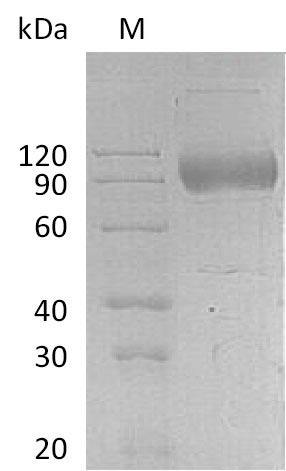Recombinant Human Interleukin-17 receptor A (IL17RA) is produced in a mammalian cell expression system, covering the extracellular region from amino acids 33 to 320. This protein is C-terminally Fc-tagged and exhibits a purity greater than 90%, as determined by SDS-PAGE. It maintains a low endotoxin level of less than 1.0 EU/µg according to the LAL method. Its biological activity is confirmed through functional ELISA, demonstrating a binding affinity with an ED50 of 13.50 ng/ml for Anti-Human IL-17RA monoclonal antibody.
Interleukin-17 receptor A (IL17RA) appears to be a crucial component of the IL-17 receptor complex, playing what seems to be a significant role in mediating immune responses. The receptor is involved in the signaling pathway of interleukin-17, a cytokine that promotes inflammatory responses. IL17RA has become essential in studies focusing on immune regulation and has been implicated in various research areas related to inflammation and immune system function.
Potential Applications
Note: The applications listed below are based on what we know about this protein's biological functions, published research, and experience from experts in the field. However, we haven't fully tested all of these applications ourselves yet. We'd recommend running some preliminary tests first to make sure they work for your specific research goals.
1. Antibody Development and Characterization
This recombinant IL17RA extracellular domain is suitable as an immunogen, but the C-terminal Fc tag may dominate the immune response, potentially reducing antibodies against IL17RA-specific epitopes. The confirmed binding to anti-IL17RA mAb indicates proper folding of some epitopes, but for antibody development, a tag-free version or cleavable tag system is recommended to ensure generation of antibodies targeting native IL17RA conformations rather than Fc-mediated epitopes.
2. Protein-Protein Interaction Studies
The Fc-tagged protein is appropriate for ligand binding studies with IL-17 family cytokines, but the Fc domain may cause steric hindrance or non-specific binding in some assay formats. While mammalian expression ensures proper glycosylation, the immobilized configuration via Fc may not replicate membrane-bound receptor orientation. For quantitative kinetics, tag-cleaved protein or controlled orientation immobilization is preferable.
3. Competitive Binding and Inhibition Assays
This application is well-supported as the Fc tag enables efficient immobilization for competitive ELISA. The established ED₅₀ (13.50 ng/ml) provides a reliable baseline for screening inhibitors. However, the extracellular domain alone may not fully replicate the binding characteristics of full-length membrane IL17RA, particularly for inhibitors that require transmembrane or intracellular domains for optimal activity.
4. Structural and Biophysical Characterization
The protein is challenging for structural studies without tag removal. The Fc tag (≈25 kDa) is larger than the extracellular domain itself, which may impede crystallization or cause heterogeneity. While biophysical characterization (e.g., SEC, DLS) is feasible, structural studies require Fc cleavage and isolation of the extracellular domain. Glycosylation may also hinder crystallization.
5. Cell-Based Receptor Binding Studies
The Fc-tagged protein can function as a decoy receptor, but the partial extracellular domain may have different affinity/avidity compared to full-length membrane receptors. The Fc tag may induce FcγR-mediated non-specific cell binding. For precise signaling inhibition, a tag-free version would be preferable to avoid confounding Fc-related effects.
Final Recommendation & Action Plan
This mammalian-expressed human IL17RA extracellular domain with C-terminal Fc tag is primarily valuable as a tool protein for in vitro binding studies and immunoassays, but has limitations for structural, therapeutic, or precise mechanistic studies due to the Fc tag and truncation. For immediate use: 1. Antibody Development: Utilize for ELISA-based antibody screening, but immunize animals with tag-free IL17RA to avoid Fc-dominated responses. 2. Interaction Studies: Employ for qualitative binding assays with IL-17 ligands, but validate kinetics with tag-cleaved protein. 3. Screening Assays: Ideal for high-throughput inhibitor screening using the established ELISA format; optimize concentrations based on the ED₅₀. 4. Biophysics: Use for initial SEC or DLS to check monodispersity, but remove Fc tag for structural studies. 5. Cell Studies: Apply as a decoy receptor at 1-10 μg/ml, but include Fc-tag controls and compare with full-length receptor effects. The mammalian expression ensures proper glycosylation, but the extracellular domain (33-320aa) may not contain all native receptor functional epitopes. Always include appropriate controls (e.g., Fc tag alone) and consider that the soluble extracellular domain may not fully replicate membrane receptor functions. For therapeutic antibody or inhibitor development, validate hits with full-length receptor cellular assays.






